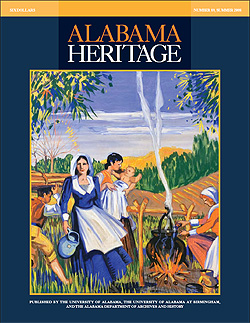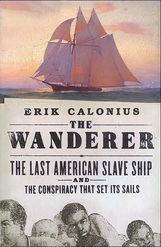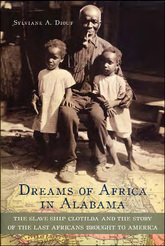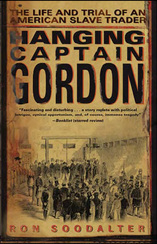|
On the cover: Detail from "Home and Family Life Begins," painted by John Augustus Walker. (Photo by Robin McDonald, courtesy Alabama Cooperative Extension System.)
|
FEATURE ABSTRACTS
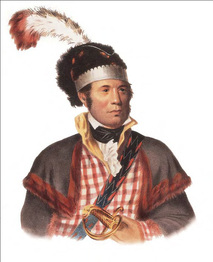 William McIntosh,
William McIntosh, who sold Creek land for personal profit
(McKenney and Hall,
"History of the Indian Tribes," 1836)
Final Resistance: Creek Removal from the Alabama Homeland
By Christopher D. Haveman
Starting in the 1820s, the removal of Creek Indians from their territory threatened to destroy their nation and, for many Creeks, their lives. After the Creek War ended, the Creeks lost substantial territory to the U. S. and in the decades following were further squeezed and driven out by squatters and corrupt land schemers. In 1836, President Jackson authorized the forcible removal of Creeks from Alabama, effectively dissolving the Creek Nation’s presence in the state.
Additional Information
The following articles in the Encyclopedia of Alabama will also be of interest:
About the Author
Christopher D. Haveman is a doctoral candidate in history studying the Creek Removal period at Auburn University. He grew up in Bellingham, Washington, and graduated from Western Washington University before receiving a master's degrees from Marquette University and Auburn University.
By Christopher D. Haveman
Starting in the 1820s, the removal of Creek Indians from their territory threatened to destroy their nation and, for many Creeks, their lives. After the Creek War ended, the Creeks lost substantial territory to the U. S. and in the decades following were further squeezed and driven out by squatters and corrupt land schemers. In 1836, President Jackson authorized the forcible removal of Creeks from Alabama, effectively dissolving the Creek Nation’s presence in the state.
Additional Information
The following articles in the Encyclopedia of Alabama will also be of interest:
- Creek Indian Removal
- Treaty of Indian Springs
- William McIntosh
- Opothle Yoholo
- Treaty of Washington, 1826
- Creek War of 1813-1814
About the Author
Christopher D. Haveman is a doctoral candidate in history studying the Creek Removal period at Auburn University. He grew up in Bellingham, Washington, and graduated from Western Washington University before receiving a master's degrees from Marquette University and Auburn University.
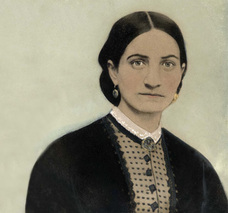 Kate Cumming
Kate Cumming(Alabama Department of Archives
and History)
Patriotism Over Propriety: Confederate Nurse Kate Cumming
By Jessica Fordham Kidd
An upper class lady from Mobile, Kate Cumming challenged social convention by joining the Confederate cause as a nurse, traveling throughout the Southeast from 1862 to 1865 to care for the wounded. Cumming detailed her work experiences in a diary, chronicling the war years from a unique perspective of a woman dedicated to the care of troops. Complete with horror, vehemence, and tenacity, Cumming’s story illustrates the complexity of a nation at war with itself.
Additional Information
Multimedia:
About the Artist
The artist of the painting of the Newnan, Georgia courthouse square featured in “Patriotism over Propriety: Confederate Nurse Kate Cumming” (pages 28 and 29) is Martin Pate. You can view Mr. Pate’s work at his website.
About the Author
Jessica Fordham Kidd is a native of Coker, Alabama. Assistant director of the First Year Writing program and instructor in the English department at the University of Alabama, Jessica holds a BS in geology and a MFA in creative writing, both from the University of Alabama. Her article “Fort Morgan: Guardian of the Bay” appeared inAlabama Heritage #87.
By Jessica Fordham Kidd
An upper class lady from Mobile, Kate Cumming challenged social convention by joining the Confederate cause as a nurse, traveling throughout the Southeast from 1862 to 1865 to care for the wounded. Cumming detailed her work experiences in a diary, chronicling the war years from a unique perspective of a woman dedicated to the care of troops. Complete with horror, vehemence, and tenacity, Cumming’s story illustrates the complexity of a nation at war with itself.
Additional Information
- Cumming, Kate. The Journal of a Confederate Nurse. Ed. Richard Barksdale Harwell. (Louisiana State University Press, 1998).
- Cunningham, H. H. Doctors in Gray: The Confederate Medical Service. (Louisiana State University Press, 1958).
- Hall, Richard H. Women on the Civil War Battlefront. (University Press of Kansas, 2006).
- Rutkow, Ira M. Bleeding Blue and Gray: Civil War Surgery and the Evolution of American Medicine. (Random House, 2005).
- Schroeder-Lein, Glenna R. Confederate Hospitals on the Move: Samuel H. Stout and the Army of Tennessee. (University of South Carolina Press, 1994).
Multimedia:
About the Artist
The artist of the painting of the Newnan, Georgia courthouse square featured in “Patriotism over Propriety: Confederate Nurse Kate Cumming” (pages 28 and 29) is Martin Pate. You can view Mr. Pate’s work at his website.
About the Author
Jessica Fordham Kidd is a native of Coker, Alabama. Assistant director of the First Year Writing program and instructor in the English department at the University of Alabama, Jessica holds a BS in geology and a MFA in creative writing, both from the University of Alabama. Her article “Fort Morgan: Guardian of the Bay” appeared inAlabama Heritage #87.
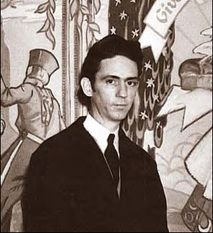 John Augustus Walker
John Augustus Walker perfected a variety of styles and media
(John A. Walker)
John Augustus Walker and the Historical Panorama of Alabama Agriculture
By Bruce Dupree
As America’s involvement in World War II became imminent, Alabamians found much-needed distraction in the 1939 State Fair and its Historical Panorama of Alabama Agriculture. Featuring ten colorful paintings by Mobile native John Augustus Walker, the exhibit highlighted the prosperity and promise of Alabama’s agricultural pursuits. The paintings illuminated many aspects of agrarian Alabama, from the livestock contributions of Spanish explorers to the advent of new technologies like tractors and electricity.
Additional Information
About the Author
Bruce Dupree is an art director with the Alabama Cooperative Extension System at Auburn University. Responsibilities with Extension include illustration, photography, and graphic design. He was the recipient of the CASE Gold Award for Illustration, and his work has been recognized by professional organizations across the country, including the Society of Illustrators. Dupree's freelance clients include the National Academy of the Sciences, the American Red Cross, Mississippi Gulf Coast Tourism, and the Professional Golf Association (PGA). Dupree has also illustrated seven children's books. Dupree received an M.A. in illustration from Syracuse University, an M.F.A. in graphic design from the University of Memphis, and a B.F.A. in art from the University of Alabama. He divides his time among his academic responsibilities, artistic ventures, and family life. The father of two teenage children, Dupree teaches 4th grade Sunday School, enjoys playing the drums, and likes spending time with his family. He lives in Auburn, Alabama.
By Bruce Dupree
As America’s involvement in World War II became imminent, Alabamians found much-needed distraction in the 1939 State Fair and its Historical Panorama of Alabama Agriculture. Featuring ten colorful paintings by Mobile native John Augustus Walker, the exhibit highlighted the prosperity and promise of Alabama’s agricultural pursuits. The paintings illuminated many aspects of agrarian Alabama, from the livestock contributions of Spanish explorers to the advent of new technologies like tractors and electricity.
Additional Information
- Ralph Draughon Library, Archives and Special Collections, Auburn University
- The Museum of Moble, Mobile, Alabama
- Alabama Cooperative Extension System, Auburn, University
- Bruce Dupree, Art Director/Communications Specialist.
About the Author
Bruce Dupree is an art director with the Alabama Cooperative Extension System at Auburn University. Responsibilities with Extension include illustration, photography, and graphic design. He was the recipient of the CASE Gold Award for Illustration, and his work has been recognized by professional organizations across the country, including the Society of Illustrators. Dupree's freelance clients include the National Academy of the Sciences, the American Red Cross, Mississippi Gulf Coast Tourism, and the Professional Golf Association (PGA). Dupree has also illustrated seven children's books. Dupree received an M.A. in illustration from Syracuse University, an M.F.A. in graphic design from the University of Memphis, and a B.F.A. in art from the University of Alabama. He divides his time among his academic responsibilities, artistic ventures, and family life. The father of two teenage children, Dupree teaches 4th grade Sunday School, enjoys playing the drums, and likes spending time with his family. He lives in Auburn, Alabama.
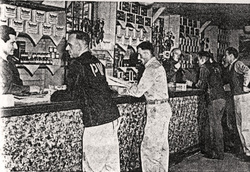 Prisoners in the canteen
Prisoners in the canteen(Max Kade Institute for
German-American Studies)
The Oasis: German POWs at Fort McClellan
By Daniel Hutchinson
During World War II, Fort McClellan, Alabama, housed over three thousand German POWs. Through the ingenuity of the prisoners and the generosity of their captors, the camp became a model facility for the humane treatment of enemy soldiers. During their captivity, the prisoners performed labor services for the Americans and participated in sports and the arts in their leisure time. The POW experience at Fort McClellan reveals a true oasis of humanity in a war often without mercy.
Additional Information
See the Alabama Heritage article about German POWs from our Winter 1988 issue.
Fort McClellan
Multimedia:
About the Author
Daniel Hutchinson is a PhD student at Florida State University in Tallahassee, Florida. Originally hailing from Hanceville, Alabama, in 2005 Daniel received his Master of Arts degree from the University of Alabama-Birmingham, where he defended a thesis on the German prisoner-of-war experience in Alabama.
By Daniel Hutchinson
During World War II, Fort McClellan, Alabama, housed over three thousand German POWs. Through the ingenuity of the prisoners and the generosity of their captors, the camp became a model facility for the humane treatment of enemy soldiers. During their captivity, the prisoners performed labor services for the Americans and participated in sports and the arts in their leisure time. The POW experience at Fort McClellan reveals a true oasis of humanity in a war often without mercy.
Additional Information
See the Alabama Heritage article about German POWs from our Winter 1988 issue.
Fort McClellan
- Cook, Ruth Beaumont. Guests Behind the Barbed Wire. (Crane Hill Publishers, 2007).
- Krammer, Arnold. Nazi Prisoners of War in America. (Scarborough House, 1991).
- Moore, Bob and Kent Federowich. Prisoners of War and Their Captors in World War II. (Berg, 1996).
Multimedia:
About the Author
Daniel Hutchinson is a PhD student at Florida State University in Tallahassee, Florida. Originally hailing from Hanceville, Alabama, in 2005 Daniel received his Master of Arts degree from the University of Alabama-Birmingham, where he defended a thesis on the German prisoner-of-war experience in Alabama.
DEPARTMENT ABSTRACTS
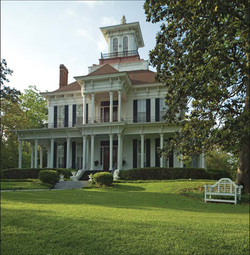 Eufaula's Kendall Manor
Eufaula's Kendall Manor(Robin McDonald)
Southern Architecture and Preservation
Alabama’s Italianate Houses
By Melanie Betz Gregory
Italianate-style architecture flourished in Alabama from 1850 to 1885, leading to the construction of homes and commercial buildings with features such as cupolas, eaves, moldings, and verandas. Although many of these structures were later destroyed or remodeled, several excellent examples of the architectural style still grace the state’s landscape.
Additional Information
To get involved with Alabama’s Preservation:
Since 1994 the Alabama Historical Commission and the Alabama Trust for Historic Preservation have joined forces to sponsor “Places in Peril,” a program that each year highlights some of the state’s significant endangered properties. As awareness yields commitment, and commitment yields action, these endangered properties can be saved and returned to their important place as treasured landmarks.
The “Places in Peril” program has helped to save many important landmarks that might otherwise have been lost. These include the Forks of Cyprus ruins in Florence (listed 1997), the John Glascock House in Tuscaloosa (listed 2001), the Lowe Mill Village in Huntsville (listed 2002), the Coleman House in Uniontown (listed 2003), and Locust Hill in Tuscumbia (listed 2004).
Everyone can play a role to help save those resources that are in peril. Adopt one of the properties. Tell everybody you know that it is important. Write letters of support. Volunteer your time or expertise to the local preservation group. If one of the places really strikes you, go ahead and buy it! A generous (or even modest) donation to the “Endangered Property Trust Fund” can help statewide.
For more information on the fund or joining the Alabama Trust for Historic Preservation, call 205-652-3497 or visit them online. For additional information on the “Places in Peril” program, visit the Alabama Historical Commission website or contact Melanie Betz at 334-242-3184.
The following articles in the Encyclopedia of Alabama will also be of interest:
About the Author
Melanie Betz Gregory, an architectural historian for the Alabama Historical Commission, is a standing co-editor of the “Southern Architecture and Preservation” department of Alabama Heritage. She wishes to thank Robert Gamble for his invaluable input.
Alabama’s Italianate Houses
By Melanie Betz Gregory
Italianate-style architecture flourished in Alabama from 1850 to 1885, leading to the construction of homes and commercial buildings with features such as cupolas, eaves, moldings, and verandas. Although many of these structures were later destroyed or remodeled, several excellent examples of the architectural style still grace the state’s landscape.
Additional Information
To get involved with Alabama’s Preservation:
Since 1994 the Alabama Historical Commission and the Alabama Trust for Historic Preservation have joined forces to sponsor “Places in Peril,” a program that each year highlights some of the state’s significant endangered properties. As awareness yields commitment, and commitment yields action, these endangered properties can be saved and returned to their important place as treasured landmarks.
The “Places in Peril” program has helped to save many important landmarks that might otherwise have been lost. These include the Forks of Cyprus ruins in Florence (listed 1997), the John Glascock House in Tuscaloosa (listed 2001), the Lowe Mill Village in Huntsville (listed 2002), the Coleman House in Uniontown (listed 2003), and Locust Hill in Tuscumbia (listed 2004).
Everyone can play a role to help save those resources that are in peril. Adopt one of the properties. Tell everybody you know that it is important. Write letters of support. Volunteer your time or expertise to the local preservation group. If one of the places really strikes you, go ahead and buy it! A generous (or even modest) donation to the “Endangered Property Trust Fund” can help statewide.
For more information on the fund or joining the Alabama Trust for Historic Preservation, call 205-652-3497 or visit them online. For additional information on the “Places in Peril” program, visit the Alabama Historical Commission website or contact Melanie Betz at 334-242-3184.
The following articles in the Encyclopedia of Alabama will also be of interest:
- First White House of the Confederacy
- Bryce Hospital (Alabama Insane Hospital)
- Plantation Architecture in Alabama
About the Author
Melanie Betz Gregory, an architectural historian for the Alabama Historical Commission, is a standing co-editor of the “Southern Architecture and Preservation” department of Alabama Heritage. She wishes to thank Robert Gamble for his invaluable input.
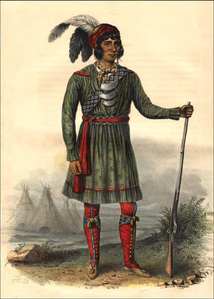 Osceola in a mixture of
Osceola in a mixture of Native American and European garments
(Alabama Department of Archives
and History)
Alabama Treasures
Osceola’s Garter
By Mary Spanos, Virginia Wimberley, and Amanda Thompson
On the day of his 1838 death, Alabama native Osceola, a leader in the fight for Native American rights, wore a decorative garter. Scholars have begun studying the garter, now held at the Alabama Department of Archives and History, to learn about its composition and what that composition reveals about the everyday lives of Native Americans.
About the Author
Based on “Osceola’s Garter: An Analysis of a Nineteenth Century Native Textile,” published in The Florida Anthropologist. The authors are all at the University of Alabama: Mary Spanos is a PhD student in the Department of Anthropology, and Virginia Wimberley and Amanda Thompson are Associate Professors in the Department of Clothing, Textiles, and Interior Design.
Osceola’s Garter
By Mary Spanos, Virginia Wimberley, and Amanda Thompson
On the day of his 1838 death, Alabama native Osceola, a leader in the fight for Native American rights, wore a decorative garter. Scholars have begun studying the garter, now held at the Alabama Department of Archives and History, to learn about its composition and what that composition reveals about the everyday lives of Native Americans.
About the Author
Based on “Osceola’s Garter: An Analysis of a Nineteenth Century Native Textile,” published in The Florida Anthropologist. The authors are all at the University of Alabama: Mary Spanos is a PhD student in the Department of Anthropology, and Virginia Wimberley and Amanda Thompson are Associate Professors in the Department of Clothing, Textiles, and Interior Design.
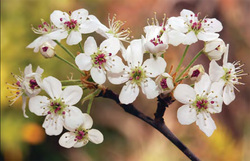 A Bradford Pear blooms
A Bradford Pear blooms(W. Mike Howell)
Nature Journal
The Rise and Fall of Bradford Pears
By Larry Davenport
Introduced in 1963, the Bradford Pear was designed as a sterile, decorative tree suitable for planting in nearly any locale. Nature, however, had other ideas, and today, the original Bradford Pear remains a plant with a mind—or at least a reproductive cycle—of its own.
Additional Information
The following article in the Encyclopedia of Alabama will also be of interest:
About the Author
Larry Davenport is a professor of biology at Samford University, Birmingham, Alabama.
The Rise and Fall of Bradford Pears
By Larry Davenport
Introduced in 1963, the Bradford Pear was designed as a sterile, decorative tree suitable for planting in nearly any locale. Nature, however, had other ideas, and today, the original Bradford Pear remains a plant with a mind—or at least a reproductive cycle—of its own.
Additional Information
The following article in the Encyclopedia of Alabama will also be of interest:
About the Author
Larry Davenport is a professor of biology at Samford University, Birmingham, Alabama.
Reading the Southern Past
Last of the Slave Trade
By Stephen Goldfarb
Several recent texts explore the slave trade in America. The Wanderer: The Last American Slave Ship and the Conspiracy that Set Its Sails (St. Martin’s Press, 2006), by Eric Calonius, follows the journey of one boat as it traveled to America in 1858. Ron Soodalter’s Hanging Captain Gordon: The Life and Trial of an American Slave Trader (Atria Books, 2006) chronicles the fate of one slave ship captain, Nathaniel Gordon. The life of an African community is commemorated in Sylviane A. Diouf’s Dreams of Africa in Alabama (Oxford University Press, 2007). Read together, these volumes offer a more complete view of the slave trade and the people involved in it.
Additional Information
The following articles in the Encyclopedia of Alabama will also be of interest:
Multimedia:
About the Author
Stephen Goldfarb holds a PhD in the history of science and technology. He retired from a public library in 2003.
Last of the Slave Trade
By Stephen Goldfarb
Several recent texts explore the slave trade in America. The Wanderer: The Last American Slave Ship and the Conspiracy that Set Its Sails (St. Martin’s Press, 2006), by Eric Calonius, follows the journey of one boat as it traveled to America in 1858. Ron Soodalter’s Hanging Captain Gordon: The Life and Trial of an American Slave Trader (Atria Books, 2006) chronicles the fate of one slave ship captain, Nathaniel Gordon. The life of an African community is commemorated in Sylviane A. Diouf’s Dreams of Africa in Alabama (Oxford University Press, 2007). Read together, these volumes offer a more complete view of the slave trade and the people involved in it.
Additional Information
The following articles in the Encyclopedia of Alabama will also be of interest:
Multimedia:
About the Author
Stephen Goldfarb holds a PhD in the history of science and technology. He retired from a public library in 2003.
